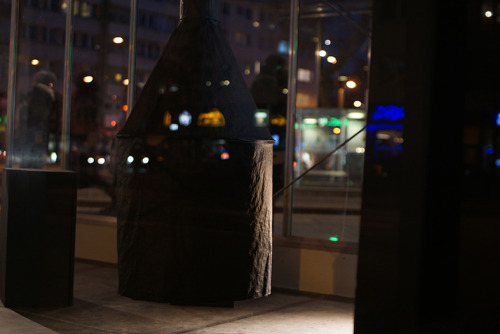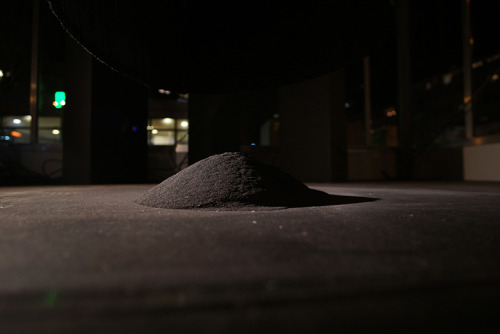TWENTY FOOT EQUIVALENT UNIT [TEU]
2017 | installation | video, audio, objects | length: 32‘00‘ loop | place: Düsseldorf
Format: 1-channel linear video on monitors, w=52 cm, pal video (25fps 1920×1080), color | audio: stereo | video: “Sleepless Nights” by Jedsada Tangtrakulwong, “Bosporus: a trilogy” by Bita Razavi, “Sans titre (Vortex)” by Julien Crepieux, “Stone Zoo” by Laurits Svendsen, “55 Bethune St. NYC” by Taiyo Kimura, “Go” by Meng Huang | Thailand, Iran/Finnland, France, Denmark, Japan, China/Germany | 3 monitors Eizo 27“, active speakers, computer with life video software | 3 pedestals: l/w/h=30/30/80 cm, 3 pedestals l/w/h=30/30/50 cm, black | oven object: r/h=50/90 cm, rings, strings red, paper blacked with ink, hanging above heap pf of ash | object graphics: w/h=120/100 cm, digital print on poster paper hanging on red thread
Hearth
It is a weekday, late afternoon when I drive into the parking lot at the shore of the big river. For my fire site, I do not choose any of the existing stone circles along the river with their piles of old ashes. I build my own ash production apparatus next to two big flat demolished concrete blocks. The fire is quickly inflamed. You strike out to collect wood. The fire burns well. I only have to poke a little bit. It has gotten dark. The freighters are still chugging up and down. Further away, on the other side of the river, planes keep taking off and landing. Now only lights are passing by. The ember glows red. It has to cool down a bit before I fill the ashes in the cookie jar to take it with me to »The Worringer Platz« in Düsseldorf.
Infinite Extension
This German term ›wohnen‹ (living) converges the concurrent significances of ›to live‹, ›to dwell‹, ›to get accustomed‹ and ›to inhabit‹. Its etymology developed in three steps: from ›wish, desire‹, to ›delight, bliss‹, to ›inhabit, to get accustomed‹. Every day routines of living (cooking, cleaning, making fire, washing, shopping, tidying up, caring, supporting…) provide us with sovereignty in thinking. Today we are increasingly required to maneuver between various realities on a daily basis, be they digital, physical, spiritual, or imagined. One can see the cause of this fragmentation in technology or in socio-cultural development, but one can just as well search into the underlying shifts of our understanding and experience of space.

Until recently our idea of space was planar, conceived from the ground and thus characterized by the classical definition of surface: its border. We are now in a transition towards a topological understanding of space, a perspective on space from within. The defining feature now is the intersection, the overlapping, and the intertwining of different kinds of spaces. If one considers artists as peculiar makers of spaces, one could see their task in creating places, where the unimaginable can become conceivable. Transnational artists are building intimate communities across vast geographical distances and are thus creating closeness. ›Proximity‹ here means existential, spatial and temporal interest. To do so they are establishing nomadic spaces, closely connected with the concept of ›wohnen‹, interest in ›the other‹ and a willingness to approbation.
Localization
For me an essential meaning of ›house‹ and ›architecture‹ lies in its underground, in its relation to soil, earth, caves. Not the factual cellar for storing goods and food, but its function as cultural cave, where time is being stored in its binned state for reclamation – a reclamation out of the future.
Hu Fang, (Vitamin art space, Guangzhou), writes about his approach to the art of gardening and farming as an »attempt to construct a ›field‹ where contemporary art, daily life and farm-oriented life practices can merge and flow together […]« (Hu Fang, Towards a Non-Intentional Space, 2015). I ask myself, if there exists an analogy, an ›art of dwelling (wohnen)‹, and how, if at all, it can be re-concealed from the progress of modernity.
›Me‹ is a woman and a man.
Twenty Foot Equivalent Unit (TEU) is the standardized loading size of containers on cargo ships
Collaborating artists: Taiyo Kimura, Japan Meng Huang, China & Germany Laurits Svendsen, Denmark Bita Razavi, Iran & Finland Jedsada Tangtrakulwong, Thailand Julien Crepieux, France

